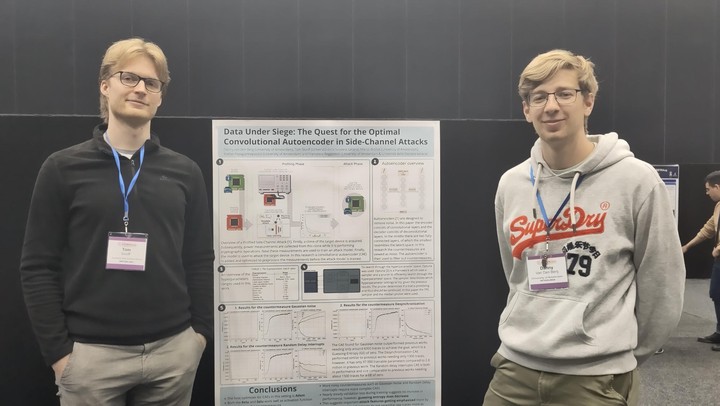Paper Presented at IJCNN 2023

Tom (left) and Danny at their research poster. Photo courtesy of Danny.
Danny van den Berg, BSc Natural and Social Sciences student majoring in Artificial Intelligence, wrote his thesis under the supervision of Tom Slooff (USI) and CCI. The resulting paper, ‘Data Under Siege: The Quest for the Optimal Convolutional Autoencoder in Side-Channel Attacks’, co-authored with Tom Slooff, Marco Brohet, Kostas Papagiannopoulos, and Francesco Regazzoni, was accepted to be presented at IJCNN 2023. Congratulations, Danny!
The International Joint Conference on Neural Networks (IJCNN) is the premier international conference in the area of neural networks theory, analysis and applications. IJCNN 2023 was hosted at the Gold Coast Convention and Exhibition Centre in Queensland, Australia.
Abstract
Encryption is a method to keep our data safe from third parties. However, side-channel information may be leaked during encryption due to physical properties. This information can be used in side-channel attacks to recover critical values such as the secret encryption key. To this end, it is necessary to understand the robustness of implementations to assess the security of data handled by a device. Side-channel attacks are one such method which allow researchers to evaluate the robustness of implementations using appropriate metrics.
In the security community, machine learning is playing a prominent role in the study of side-channel attacks. A notable example of this is the use of Convolutional Autoencoders (CAE) as a preprocessing step on the measurements. In this work we study in depth the problem of finding the most suitable architecture of such Convolutional Autoencoders. To this end, Optuna is used to explore the CAE hyperparameter space. This process allows us to identify hyperparameters that outperform state-of-the-art autoencoders, reducing the needed traces for a succesful attack by approximately 37% in the presence of Gaussian noise and reducing the trainable parameters needed to attack desynchronization by a factor of 29. In addition to the promising results, experiments carried out in this paper allow a better understanding of the hyperparameter space in the field of side channel attacks, providing a solid base for future use of CAE in this specific domain.